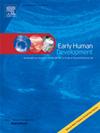母体经验胎儿运动从儿童AMC: MECA调查
IF 2
3区 医学
Q2 OBSTETRICS & GYNECOLOGY
引用次数: 0
摘要
目的目前普遍认为,患有多重先天性关节挛缩症(AMC)的孕妇胎儿运动总是缺失或减少,从而导致母亲在患病妊娠期间没有感知到或感知到较少的胎儿运动。本研究的目的是调查孕妇对胎儿运动的感知与诊断为AMC的孩子,并挑战这一假设。此外,它试图通过与未受AMC影响的儿童的怀孕进行比较,扩大目前对认知的了解。方法与国际患者支持组织合作开展了一项基于调查的研究。调查对象包括至少有一个孩子被诊断患有AMC的母亲。问卷不仅包括运动的存在,还包括其他方面,如日常运动,整个怀孕期间的一致性,以及感知正常。对受影响妊娠和未受影响妊娠的母亲进行亚组比较,以及妊娠顺序及其对临床随访的影响。结果共170名母亲参加了本次调查,其中118名(70%)同时发生了感染和未感染的妊娠,52名(30%)仅发生了感染儿童的妊娠。大多数(77%)孕妇在受amc影响的妊娠期间感觉到胎动,但与未受影响的妊娠相比,较少的孕妇将其描述为每天(66%)、稳定(51%)或正常(44%)。结论本研究表明,绝大多数患有AMC患儿的母亲能够感知胎儿运动。在胎儿挛缩的情况下,胎动的存在不应排除AMC的可能性。本文章由计算机程序翻译,如有差异,请以英文原文为准。
Maternal experience of fetal movements from a child with AMC: MECA survey
Objective
The prevailing assumption is that fetal movements are always absent or reduced in pregnancies affected by arthrogryposis multiplex congenita (AMC), leading to the belief that mothers do not perceive or perceive less fetal movements during affected pregnancies. This study aims to investigate the maternal perception of fetal movements in pregnancies with a child diagnosed with AMC and to challenge this assumption. Additionally, it seeks to expand current knowledge on the perception by comparing with pregnancies with children not affected by AMC.
Methods
A survey-based study was conducted in collaboration with international patient support groups. The survey included mothers with at least one child diagnosed with AMC. The questionnaire covered not only the presence of movements, but also other aspects such as daily movements, consistency throughout the pregnancy, and perceived normalcy. A subgroup comparison was made between mothers who had both an affected and non-affected pregnancy, as well as by pregnancy order and its impact on clinical follow-up.
Results
A total of 170 mothers participated in this survey and 118 (70 %) of them had both an affected and non-affected pregnancy and 52 (30 %) had pregnancies with AMC-affected children alone. Most (77 %) perceived fetal movements during AMC-affected pregnancies, though fewer described them as daily (66 %), stable (51 %), or normal (44 %) compared to unaffected pregnancies.
Conclusion
This study showed that fetal movements can be perceived by the majority of mothers of children with AMC. The presence of fetal movements should not rule out the possibility of AMC in case of fetal contractures.
求助全文
通过发布文献求助,成功后即可免费获取论文全文。
去求助
来源期刊

Early human development
医学-妇产科学
CiteScore
4.40
自引率
4.00%
发文量
100
审稿时长
46 days
期刊介绍:
Established as an authoritative, highly cited voice on early human development, Early Human Development provides a unique opportunity for researchers and clinicians to bridge the communication gap between disciplines. Creating a forum for the productive exchange of ideas concerning early human growth and development, the journal publishes original research and clinical papers with particular emphasis on the continuum between fetal life and the perinatal period; aspects of postnatal growth influenced by early events; and the safeguarding of the quality of human survival.
The first comprehensive and interdisciplinary journal in this area of growing importance, Early Human Development offers pertinent contributions to the following subject areas:
Fetology; perinatology; pediatrics; growth and development; obstetrics; reproduction and fertility; epidemiology; behavioural sciences; nutrition and metabolism; teratology; neurology; brain biology; developmental psychology and screening.
 求助内容:
求助内容: 应助结果提醒方式:
应助结果提醒方式:


